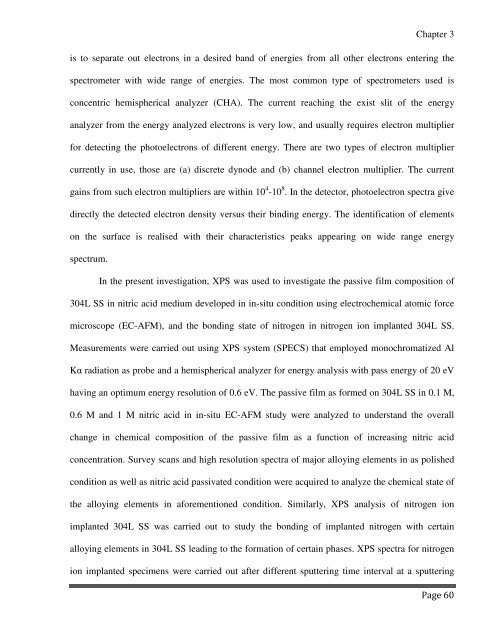CHEM02200704003 Nilamadhab Pandhy - Homi Bhabha National ...
CHEM02200704003 Nilamadhab Pandhy - Homi Bhabha National ...
CHEM02200704003 Nilamadhab Pandhy - Homi Bhabha National ...
Create successful ePaper yourself
Turn your PDF publications into a flip-book with our unique Google optimized e-Paper software.
Chapter 3<br />
is to separate out electrons in a desired band of energies from all other electrons entering the<br />
spectrometer with wide range of energies. The most common type of spectrometers used is<br />
concentric hemispherical analyzer (CHA). The current reaching the exist slit of the energy<br />
analyzer from the energy analyzed electrons is very low, and usually requires electron multiplier<br />
for detecting the photoelectrons of different energy. There are two types of electron multiplier<br />
currently in use, those are (a) discrete dynode and (b) channel electron multiplier. The current<br />
gains from such electron multipliers are within 10 4 -10 8 . In the detector, photoelectron spectra give<br />
directly the detected electron density versus their binding energy. The identification of elements<br />
on the surface is realised with their characteristics peaks appearing on wide range energy<br />
spectrum.<br />
In the present investigation, XPS was used to investigate the passive film composition of<br />
304L SS in nitric acid medium developed in in-situ condition using electrochemical atomic force<br />
microscope (EC-AFM), and the bonding state of nitrogen in nitrogen ion implanted 304L SS.<br />
Measurements were carried out using XPS system (SPECS) that employed monochromatized Al<br />
K radiation as probe and a hemispherical analyzer for energy analysis with pass energy of 20 eV<br />
having an optimum energy resolution of 0.6 eV. The passive film as formed on 304L SS in 0.1 M,<br />
0.6 M and 1 M nitric acid in in-situ EC-AFM study were analyzed to understand the overall<br />
change in chemical composition of the passive film as a function of increasing nitric acid<br />
concentration. Survey scans and high resolution spectra of major alloying elements in as polished<br />
condition as well as nitric acid passivated condition were acquired to analyze the chemical state of<br />
the alloying elements in aforementioned condition. Similarly, XPS analysis of nitrogen ion<br />
implanted 304L SS was carried out to study the bonding of implanted nitrogen with certain<br />
alloying elements in 304L SS leading to the formation of certain phases. XPS spectra for nitrogen<br />
ion implanted specimens were carried out after different sputtering time interval at a sputtering
















